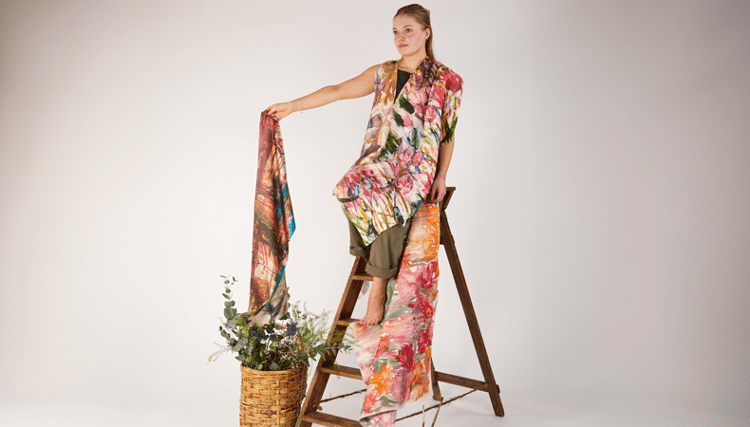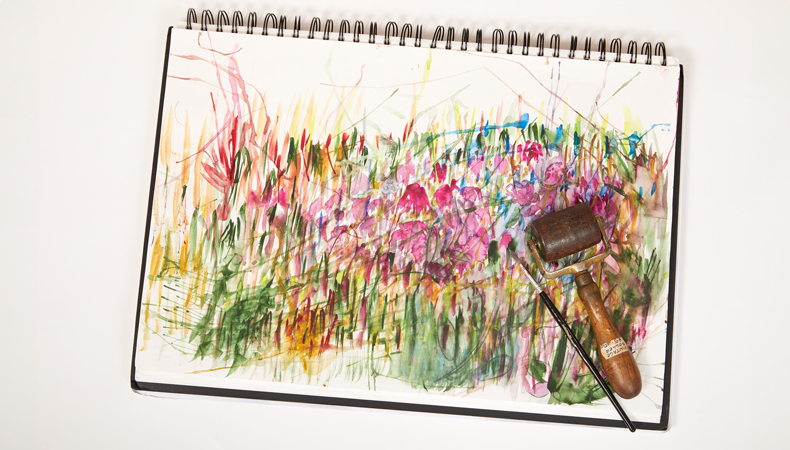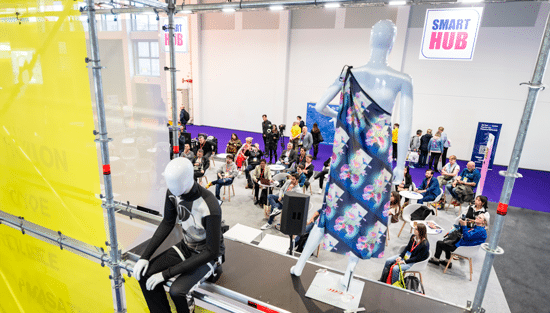Sustainability, seaweed and storytelling

Joanne O’Rourke, winner of the Epson Design Award, discusses the interface between storytelling, nature, craft and innovation in her business, and how the Personalisation Experience 2025 was a career-defining moment.
Sustainability is not a limitation – it’s a driver of innovation. At this year’s SmartHub Conference held at the Personalisation Experience 2025 in Berlin a few weeks ago, I was honoured to share my journey as a fine art and textile designer working at the intersection of nature, craft and innovation.
The experience was made even more special by winning the Epson Design Award – a huge milestone in my career and a reminder of the importance of storytelling in sustainable design.
I’m the founder of Finch Marsh, a brand rooted in environmental responsibility and emotional connection. My creative process bridges the handcrafted and the digital, transforming seaweed and natural dyes into contemporary surface design.
A design journey anchored in nature
My journey began at Norwich University of the Arts, where I studied a BA in textile design. During those three years, I focused on both digital and handcraft techniques, culminating in an exhibition at New Designers. From there, I was selected to join Green Grads UK, which gave me the opportunity to exhibit in London and Manchester and ultimately brought me to FESPA.
The heart of my practice is shaped by the natural world — not just as inspiration, but as an active collaborator. My materials often include deadstock fabrics, algae-based dyes, and pressed seaweed, creating deeply textural pieces with minimal environmental impact.
I use the sea and its materials as both a subject and a tool. Every piece is a quiet collaboration with nature, and every print carries that story forward.
Core brand values
At Finch Marsh, my work is built on five brand pillars:
-
Crafted by Nature – embracing natural imperfections and organic aesthetics
-
Slow Emotional Design – making work that connects and lingers
-
Regenerative Materials – sourcing consciously and reducing waste
-
Ocean-Rooted Storytelling – letting the sea shape my process and message
-
Modern Heritage – blending ancient practices with contemporary relevance
These are not just values; they are decisions I return to in every design. Whether I’m painting with eco-dyes or refining scans in Photoshop, those five principles hold me accountable.
A fusion of craft and technology
In my presentation, I spoke to the audience about how I blend hand-dyeing and digital techniques to support customisation and sustainable production.
I start by painting with natural dyes onto fabric, often in large-scale compositions. Then, using a flatbed scanner, I digitise these artworks, edit them delicately in Photoshop, and prepare them for on-demand digital printing.

I want each piece to retain the intimacy of something handmade — even when it’s reproduced at scale.
This approach not only reduces waste but allows for personalisation without compromising artistic integrity. It creates products that feel emotionally and materially rich.
Beyond decoration: design as story
For me, design isn’t just surface deep. It’s a vehicle for connection between designer and user, between nature and technology.
I believe that people today are hungry for meaning. They want their interiors, their fashion, their objects to reflect values. And that’s where design can lead.
At FESPA, I spoke about how storytelling is embedded in every step of my process — from foraging seaweed to the final digital file. It’s about making objects that feel alive, that resonate, and that last.
Materials and methods
My process is low-impact and high-emotion. Using indigo, seaweed resists and ancient dye techniques, I create pieces that are both ecologically sound and visually compelling. I use pressed seaweed and seaweed-derived pigments in my process. The seaweed acts as a natural resist and creates beautiful, organic imprints when layered with indigo and algae-based dyes. These natural pigments are water-based and low-impact, giving the work a strong environmental foundation. It’s a way of embedding the rhythm of the coast directly into the work, both in form and meaning. Nature isn’t just my inspiration – it’s my co-designer.
I work with minimal water, avoid harmful chemicals, and seek out techniques that have endured for centuries. My work is slow, thoughtful, and designed to be part of a more sustainable future.
Looking ahead
Being recognised by Epson UK with the Epson Design Award was a moment of huge gratitude and encouragement.
Winning the Epson Award felt like a full-circle moment – validation for bringing together natural process with digital potential. I’m honoured, and it makes me even more excited for what’s next.
Epson’s support for emerging talent and sustainable design is a meaningful step in pushing our industry forward. I’m deeply thankful to the judges and to the FESPA team for making space for voices like mine.
This talk was just the beginning. I’ll be continuing the conversation at Ocean Talks with Boat International, where I’ll be showcasing my work for the luxury interior and yacht market – a new arena for sustainable surface design.
My practice will remain grounded in nature, driven by customisation, and committed to ethical making.
Quiz: Rethinking textile impact
At the end of my session, I shared a short quiz to help reframe the urgency of sustainability in our industry. Here’s a snapshot for Club FESPA readers to consider:
-
How many tonnes of textiles are landfilled globally each year?
Over 92 million tonnes – that’s one garbage truck every second. -
How much water does it take to make one cotton T-shirt?
Around 2,700 litres – what one person drinks in 2.5 years. -
How much UK landfill is from clothing alone?
Over 350,000 tonnes annually. -
How much fashion stock is unsold each year?
Around 30% – almost one in three garments. -
How long does it take for polyester to decompose?
Up to 200 years.
These numbers aren’t just facts — they’re a call to action.
Final words
FESPA was a career-defining opportunity — not just for sharing my work, but for connecting with other creatives, brands, and thinkers who care about our future.
I believe that design can be both sustainable and beautiful. We don’t have to choose. We just have to care enough to try.
To the next generation of designers and students: your voice matters. Keep experimenting, stay curious, and let nature be part of your process. You’re not just the future of this industry – you’re already shaping it.
If you’d like to follow my journey or collaborate, find me here @finch_marsh on Instagram – I am always open to conversations. Let’s keep designing a better future – together.
Become a FESPA member to continue reading
To read more and access exclusive content on the Club FESPA portal, please contact your Local Association. If you are not a current member, please enquire here. If there is no FESPA Association in your country, you can join FESPA Direct. Once you become a FESPA member, you can gain access to the Club FESPA Portal.
Recent news

What’s new in stamping foils? Bringing extra sparkle to print products
Stamping foil can help your products to really stand out – and you can probably do it with the equipment you already have. We speak to Matt Hornby of foil specialists Foilco.

The intelligence behind the ink: how AI is changing printing forever
Keypoint Intelligence, the global market data leader for the digital imaging industry, showed the growing application of artificial intelligence to all facets of printing at the SmartHub Conference at the Personalisation Experience 2025, co-located at the FESPA Global Print Expo earlier this month.

Regulation guidance: CS3D
How does the Corporate Sustainability Due Diligence Directive (CS3D) affect printers, and what do they need to do to ensure compliance? Sustainability consultant Rachel England outlines everything you need to know.

How to choose the best courier for safe shipping
As a printer, making sure your work is high-quality is only half the job – delivering to the customer on time and intact is just as important. Reliable courier services are vital for your business reputation, so here’s what to look for in a delivery partner, and why automation may be one way you can boost your business.